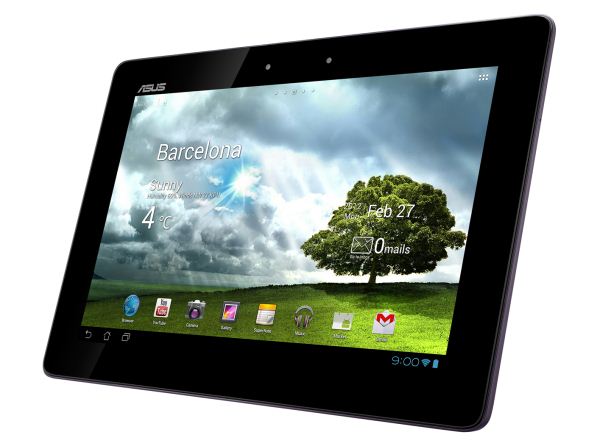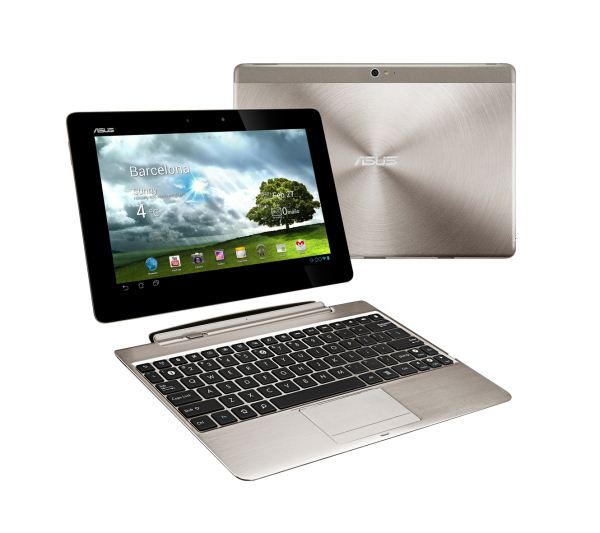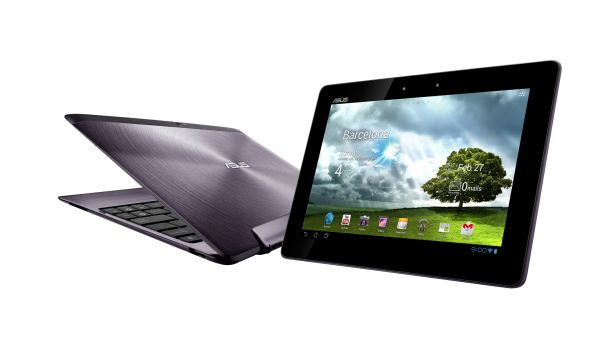The ASUS Transformer Pad Infinity: 1920 x 1200 Display, Krait Optional
by Anand Lal Shimpi on February 27, 2012 5:30 AM ESTThe Eee Pad brand is gone, ASUS has officially reduced it to just Transformer Pad. One of the first tablets to carry the new Transformer Pad brand is one we saw at CES. Back then it was known as the Eee Pad Transformer Prime TF700T, but now it's simply the ASUS Transformer Pad Infinity.
Equipped with a 10.1-inch Super IPS+ 1920 x 1200 display, the Transformer Pad Infinity is ASUS' new high-end Android tablet. The WiFi version will ship with a 1.6GHz NVIDIA Tegra 3 SoC, a speed bump up from the 1.3-1.4GHz part that shipped in the original TF Prime. The big surprirse is the 3G/4G LTE version will use a Snapdragon S4 MSM8960 based on Qualcomm's new 28nm Krait architecture. According to ASUS' specs, the Infinity gets a 13.6% increase in battery capacity compared to the Transformer Prime - probably to help offset the increased power consumption from lighting the 2.3MP display.
The TF Pad Infinity is slightly thicker than the TF Prime but the dimensions and weight apparently remain unchanged. The aluminum body is still available in two colors: amethyst grey and champagne gold. Just as we saw at CES, there's a plastic RF window strip across the back of the tablet to improve WiFi/GPS reception.
The TF Pad Infinity is also available with an optional mobile dock featuring an additional 22Whr battery. The dock measures 263mm x 180.8mm x 8 - 10.4mm and weighs 537g.
We're expecting pricing to be north of $599 depending on capacity and wireless connectivity. Although NVIDIA's Tegra 3 seemed to handle the higher resolution of the Infinity fine at CES, the Snapdragon S4 version could be even smoother thanks to its dual-channel memory controller. Expect availability to be limited based on panel supply, at least early on.
| Tablet Specification Comparison | ||||||
| ASUS Eee Pad Transformer | ASUS Eee Pad Transformer Prime | ASUS Transformer Pad Infinity | Apple iPad 2 | |||
| Dimensions | 271mm x 175mm x 12.95mm | 263 x 180.8 x 8.3mm | 263 x 180.8 x 8.5mm | 241.2 x 185.7 x 8.8mm | ||
| Display | 10.1-inch 1280 x 800 | 10.1-inch 1280 x 800 Super IPS+ | 10.1-inch 1920 x 1200 Super IPS+ | 9.7-inch 1024 x 768 IPS | ||
| Weight | 675g | 586g | 586g | 601g | ||
| Processor | 1GHz NVIDIA Tegra 2 (2 x Cortex A9) | 1.3GHz NVIDIA Tegra 3 (4 x Cortex A9) |
3G/4G LTE - 1.5GHz Qualcomm Snapdragon S4 MSM8960 (2 x Krait) WiFi - 1.6GHz NVIDIA Tegra 3 T33 (4 x Cortex A9) |
1GHz Apple A5 (2 x Cortex A9) | ||
| Memory | 1GB | 1GB | 1GB | 512MB | ||
| Storage | 16GB + microSD card | 32GB/64GB + microSD slot | 16GB - 64GB | 16GB | ||
| Battery | 24.4Whr | 22Whr | 25Whr | 25Whr | ||
| Pricing | $399 | $499/$599 | $599 - $799 est | $499 | ||


















20 Comments
View All Comments
Rits - Monday, February 27, 2012 - link
I can't wait for Anandtech to put the new Tegra3 and S4 versions through the paces and see how they compare. I just wish they put in the the awesome S4 "Pro" with the Adreno 320 in this thing!ViRGE - Monday, February 27, 2012 - link
This is starting to get infuriating. Asus is now one of several companies to release a product under a single name, and then use widely different SoCs among the sub-variants. As a result consumers are getting the short end of the stick as the products aren't necessarily what they think they're getting.Pick a SoC and stick to it. And if you can't do that, then don't name different products the same thing.
MrSpadge - Monday, February 27, 2012 - link
The idea is that what counts for the customer is the "transformer"-thing. The actual hardware inside should less important for actual use of the device. Well, I'm not saying this is the best or even a good idea..MonkeyPaw - Monday, February 27, 2012 - link
Isn't this what we see for PCs and notebooks already? Tablets are going to go the same route. So long as retailers can keep the specs straight, the usual "buyer beware" applies. If Transformer "A" is $100 cheaper than Transformer "B," some sort of warning should be going off in people's heads.Aikouka - Monday, February 27, 2012 - link
I assume ASUS did it to ensure compatibility with the (presumably) more efficient LTE modem that's available with the 8960. There is a separate modem available as Anand outlined in the 8960 article; however, I don't recall nVidia's statement (from last week) including Qualcomm in their dedicated LTE compatibility.In other words, ASUS could probably put up with the headache of ensuring the newer Qualcomm LTE modem works fine with Tegra 3 or just go with the SoC that it's literally built into.
ViRGE - Monday, February 27, 2012 - link
I'm agree that's probably the reason. But in that case both Infinities should be using MSM8960, not just the one with a modem.chrnochime - Monday, February 27, 2012 - link
Then don't buy it if it's so infuriating for you. Either that or go be a director at Asus and make them change their ways.kyuu - Monday, February 27, 2012 - link
I have to agree. They should've just used Qualcomm's solution in both variants, rather than sticking those who don't want 3G/LTE connectivity with the older Tegra and it's single-channel memory controller.Stormkroe - Friday, March 2, 2012 - link
Ford makes the F150 with more than 5 engines, yet the rest of the truck is virtually identical. Should they quit calling all of them F150's? Consumers can usually read, and it's not like one soc is the porterhouse and the other is a hotdog even if they were too dumb to know.prophet001 - Monday, February 27, 2012 - link
Which SoC is expected to be faster?